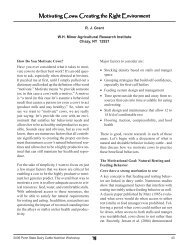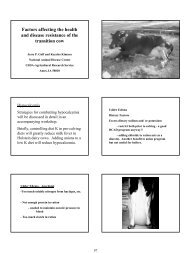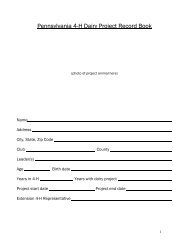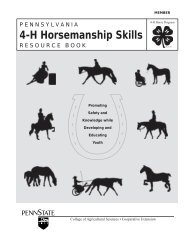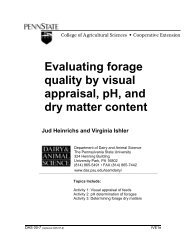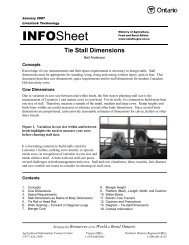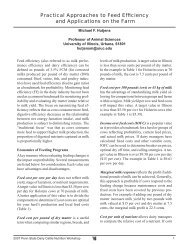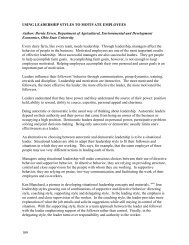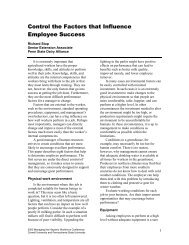DETERMINING THE MINERAL REQUIREMENT OF DAIRY CATTLE
DETERMINING THE MINERAL REQUIREMENT OF DAIRY CATTLE
DETERMINING THE MINERAL REQUIREMENT OF DAIRY CATTLE
You also want an ePaper? Increase the reach of your titles
YUMPU automatically turns print PDFs into web optimized ePapers that Google loves.
cows". This syndrome often begins as milk fever but unlike the typical milk fever cow,<br />
plasma Phos remains low in some of these cows despite successful treatment of the<br />
hypocalcemia. Protracted hypophosphatemia in these cows appears to be an important<br />
factor in the inability of these animals to rise to their feet, but why plasma Phos remains low<br />
is unclear.<br />
Magnesium (Mg)<br />
Despite the importance of Mg there is no hormonal mechanism concerned principally<br />
and directly with Mg homeostasis. The kidneys play a key role in maintaining Mg<br />
homeostasis, but only under conditions of hypermagnesemia. If dietary Mg is absorbed in<br />
excess of needs plasma Mg concentration rises above the renal threshold for reabsorption<br />
of Mg and the excess is excreted into the urine. The renal threshold for Mg, i.e. the plasma<br />
Mg concentration at which all Mg filtered across the glomerulus is reabsorbed is 0.75 -0.90<br />
mmol/L or 1.8 - 2.2 mg/100 ml.<br />
Plasma Mg concentrations below these levels indicate that dietary Mg absorption is<br />
not sufficient and little or no Mg will be detected in urine. Parathyroid hormone, released in<br />
response to hypocalcemia, raises the renal threshold for both Ca and Mg. The result is<br />
that during hypocalcemia plasma Mg concentrations will increase if dietary Mg absorption<br />
is adequate. This is often the case in cows suffering from milk fever. If plasma Mg is<br />
below 0.75 mmol/L or 1.8 mg/dl (suggesting inadequate dietary Mg absorption) raising the<br />
renal threshold further will not increase plasma Mg (Goff, 1998).<br />
Bone is not a significant source of Mg that can be utilized in times of Mg deficit, as<br />
bone resorption occurs in response to Ca homeostasis, not Mg status. Maintenance of<br />
normal plasma Mg concentration is nearly totally dependent on a constant supply of dietary<br />
Mg.<br />
Mg is absorbed primarily from the ileum and colon of monogastric animals and young<br />
ruminants. Mg absorption is by passive absorption and is therefore dependent on the<br />
concentration of Mg ions in the digesta. As the rumen and reticulum develop these organs<br />
become the main, and perhaps the only, site for Mg absorption in adult ruminants. In adult<br />
ruminants the small intestine is a site of net secretion of Mg.<br />
Hypomagnesemic syndromes of cattle and ewes<br />
Hypomagnesemic tetany is most often associated with beef cows and ewes in early<br />
lactation grazing lush pastures high in K and nitrogen and low in Mg and Na. This is the<br />
most common situation and it is often referred to as Grass Tetany, Spring Tetany, Grass<br />
Staggers or Lactation Tetany. Mg deficiency occurs most often in spring or fall when<br />
pastures are growing at maximal rates, and is most common in grazing lactating ruminants<br />
as milk production removes 0.15 g Mg from the blood for each liter of milk produced. Ewes<br />
suckling more than one lamb and higher producing cows are at greatest risk. Mg must be<br />
constantly ingested as it cannot be mobilized from body tissues to maintain normal plasma<br />
Mg concentrations. Conditions associated with hypomagnesemia as a result of feed<br />
restriction include transport over long distance (Transport Tetany) or sudden exposure to<br />
inclement weather. Cows can also develop hypomagnesemia in late gestation which is<br />
often associated with and complicated by inadequate energy intake. This syndrome is<br />
sometimes referred to as winter tetany and is seen in animals turned out in winter to feed<br />
on crop residues such as corn stalks or straw. Animals grazing wheat pasture (Wheat<br />
Pasture Tetany) or other early growth cereal forages can develop hypomagnesemia with<br />
concurrent severe hypocalcemia resulting in a clinical picture that more closely resembles<br />
milk fever. Hypomagnesemia can also occur in calves, especially if fed only milk or milk<br />
replacer beyond the first two months of age (Milk Tetany).<br />
40




